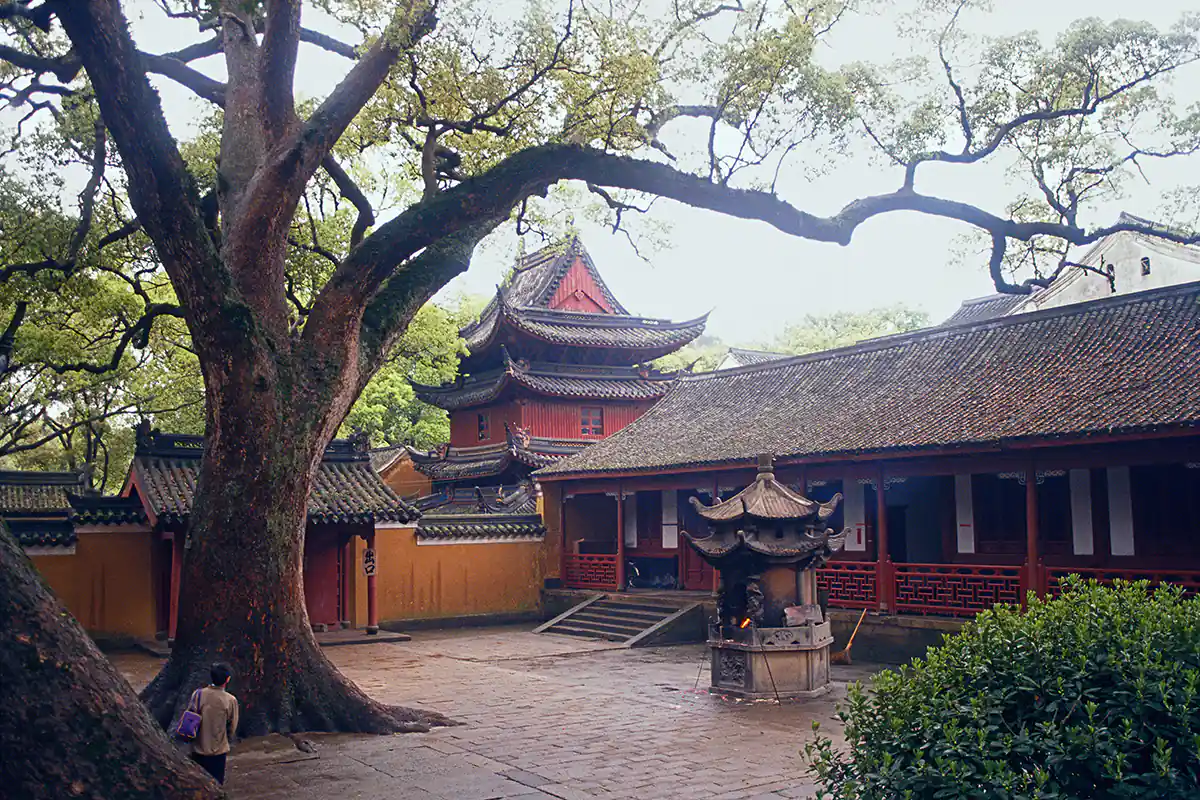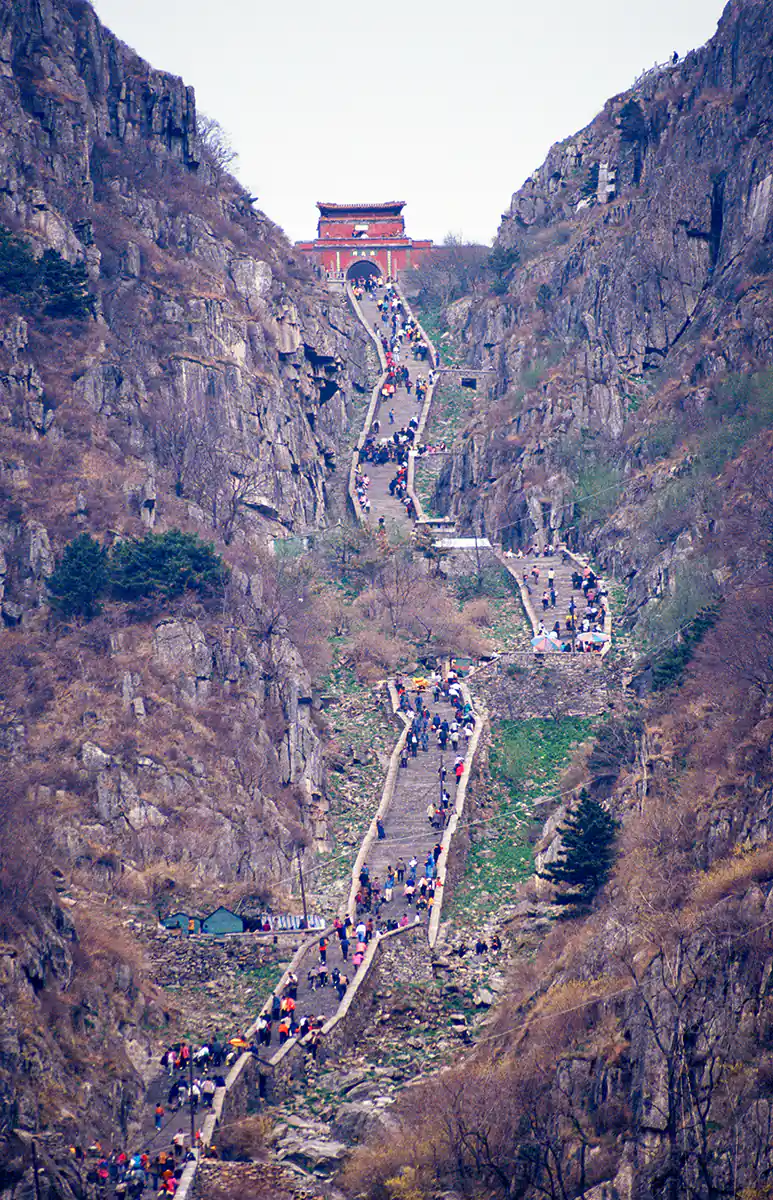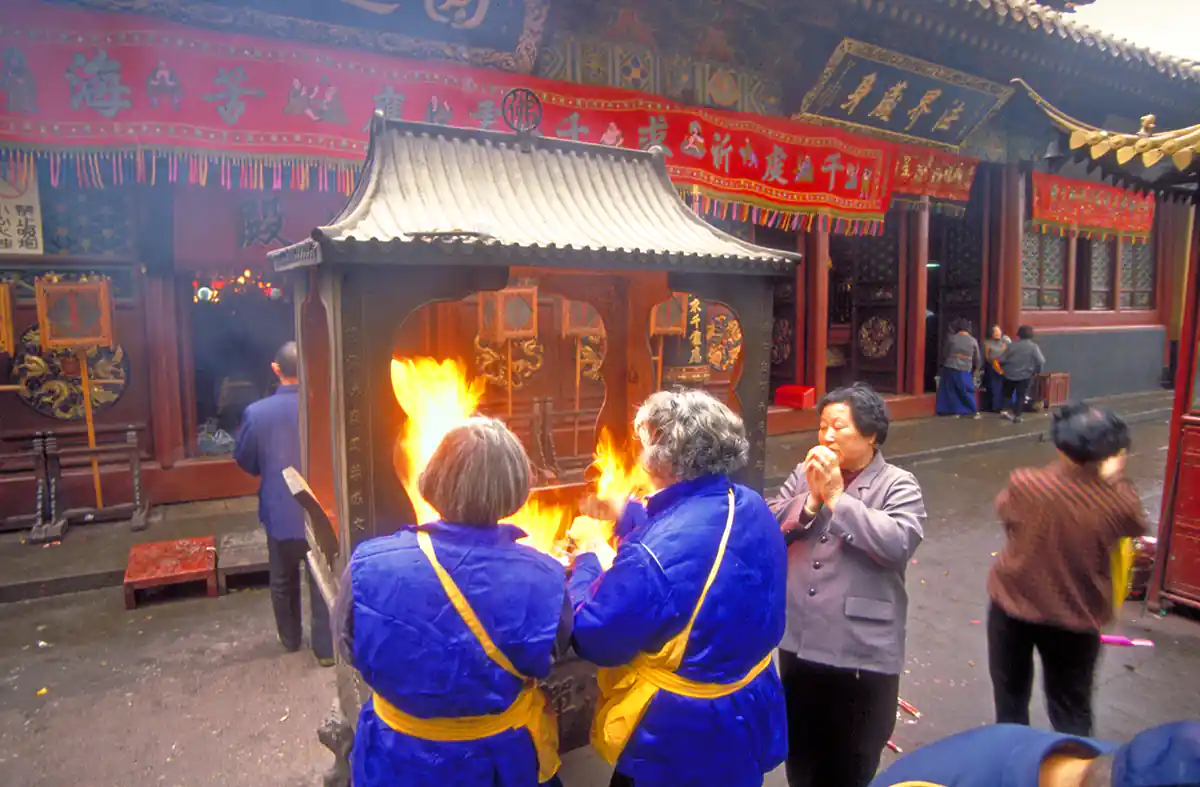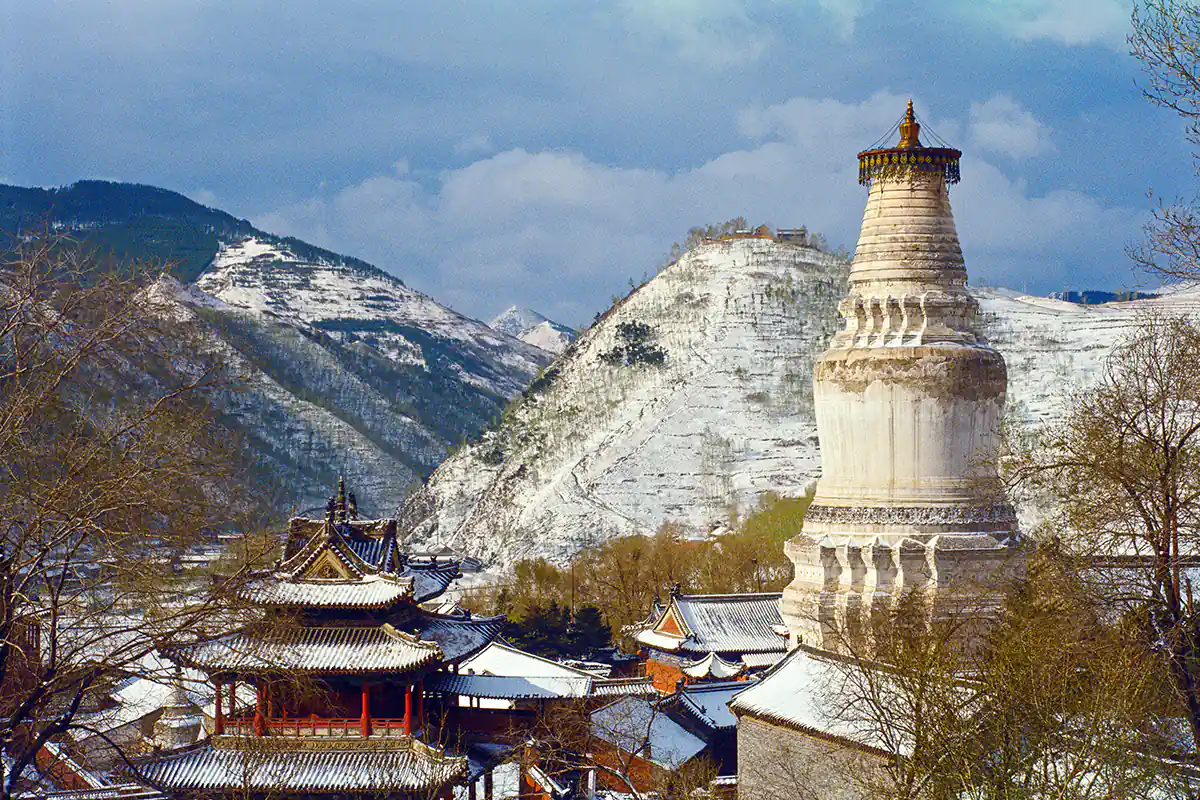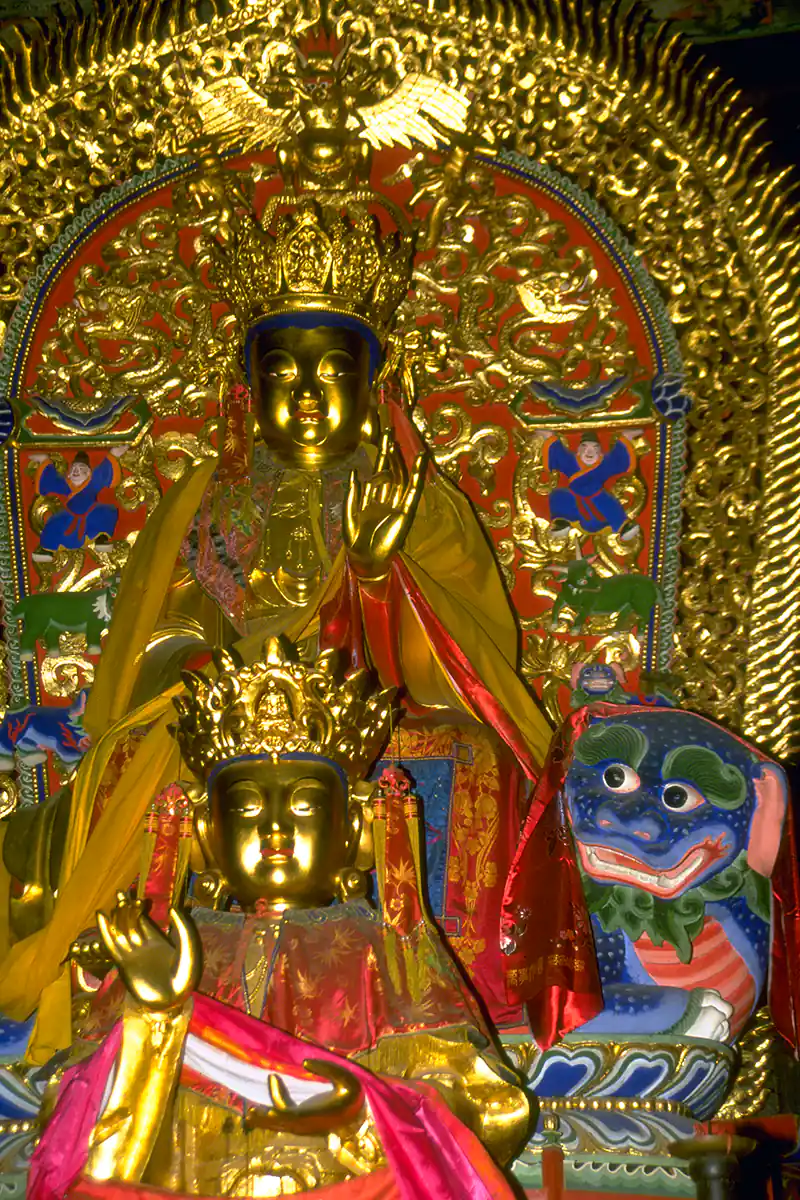Sacred Mountains of China
With accurate historical records of events over three thousand years ago, China has some of the oldest recorded history of any country. It is from the legendary era; however, long before historical records were compiled, we find the first mention of sacred mountains in China. Why were certain mountains believed to be holy? Perhaps the most primitive reason was the belief that mountains, especially the tallest ones, were pillars separating heaven from earth. According to one ancient Chinese cosmologist, the realm of heaven covered the realm of earth, and from this belief arose the idea that heaven could fall if it were not supported. The mountains were believed to perform this function. In the 'Reparation of Heaven' myth, the Goddess Nu Wa, having repaired the broken sky, killed a huge turtle and erected its four feet as supporting pillars in the four quarters. These four pillars allowed the world to enjoy a peaceful and harmonious life again and later came to be regarded as the earliest sacred mountains.
Another reason for sanctifying particular mountains is the legends and myths of shamanism and early Taoism. These legends speak of sages and mystics, often called 'immortals,' who lived deep in the mountain wilderness, on diets of rare herbs and exotic elixirs, and lived 400 to 800 years old. The mountain areas where these sages dwelled came to be regarded as sacred places, as access points to the heavenly realm, and also as the abodes of magical spirits and powerful deities (in the Chinese context, a sacred mountain can mean a single peak, a cluster of hills, or a whole mountain range).
The Shu-ching, a classic of traditional history compiled around the fifth century BC, mentions how the ruler Shun (2255-2206 BC) went every five years on a pilgrimage to the four mountains that defined the limits of his realm. Offering a sacrifice on the summit of each mountain, he began a tradition that has lasted to the present age (it is interesting to note that the Chinese phrase for pilgrimage - ch' ao-shan chin-hsiang - means 'paying one's respect to a mountain'). While only one of these mountains, Tai Shan (originally called Tai Tsung), was referred to by name in the Shu-ching, from other sources, we learn that the following five mountains were highly revered by the Taoists in ancient times:
- Tai Shan, Taoist mountain of the east, Shandong province, 1545 meters.
- Heng Shan Bei, Taoist mountain of the north, Shanxi province, 2017 meters.
- Hua Shan, Taoist mountain of the west, Shanxi province, 1997 meters.
- Heng Shan Nan, Taoist mountain of the south, Hunan province, 1290 meters.
- Song Shan, Taoist mountain of the center, Henan province, 1494 meters.
These mountains were not, however, the only or even the most important of the Taoist sacred peaks. Writing in Pilgrims and Sacred Sites in China (listed in the bibliography under Naquin), John Lagerwey comments:
"A note on what is meant by "Taoist mountain" is perhaps in order here. It is traditional to regard the Five Peaks (wu-yueh) as Taoist, in contrast with the "four most famous (Buddhist) mountains" (ssu-ta ming shan). While both history and cosmology can be called on to justify this identification of the Five Peaks with Taoism, these mountains already constituted a distinct group in the Former Han dynasty before Taoism had taken on an organized ecclesiastical form, and it is only from the late sixth century on that Taoists made a concerted effort to claim these mountains as theirs. The Taoists were never entirely successful in pressing this claim, and of the five only Hua Shan and T'ai Shan, albeit in a very different manner, play a significant and ongoing role in Taoist religious history. Perhaps even more to the point, even these two mountains are nowhere near as important to Taoist history as are such mountains as Mao Shan and Lung-hu Shan, centers, respectively, of Shang-ch'ing and Cheng-i Taoism. Together with Ko-tsao Shan (in Kiangsi), the ordination center of Ling-pao Taoism, these mountains constituted the "tripod" on which officially recognized forms of Taoism rested from the early twelfth century on."
In the 1st century AD, merchants returning from India via the Silk Route began the introduction of Buddhism into China. Over the next few centuries, adventurous Chinese pilgrims traveled to India to visit the sacred places of the Buddha’s life. The most famous pilgrim was Hsuan-Tsang (596-664), the Tripitaka Master, who spent sixteen years in India. These pilgrims returned with translations of Buddhist texts and, equally important, with an affinity for the Buddhist tradition of monastic life. Like Taoist hermits, Buddhist monks favored quiet mountains and deep forests for their meditative practices. Small hermitages and later great monastic complexes sprung up at many peaks (some previously held sacred by the Taoists), and over the centuries, the Buddhists began to regard four peaks as having primary sanctity:
- Pu Tuo Shan, Buddhist mountain of the east, Zhejiang province, 284 meters. Sacred to Kuan-Yin, the Bodhisattva of Compassion.
- Wu Tai Shan, Buddhist mountain of the north, Shanxi province, 3061 meters. Sacred to Manjushri, the Bodhisattva of Wisdom.
- Emei Shan, Buddhist mountain of the west, Sichuan province, 3099 meters. Sacred to Samantabhadra, the Bodhisattva of Benevolent Action.
- Jiu Hua Shan, Buddhist mountain of the south, Anhui province, 1341 meters. Sacred to Kshitigarbha, the Bodhisattva of Salvation.
Each of the Buddhist sacred mountains is considered to be the dwelling place of a Bodhisattva. These particular Bodhisattvas are mythological spiritual beings dedicated to assisting all sentient creatures in the transcendence of worldly suffering and attaining enlightenment. The Buddhist mountains and the Taoist peaks above became the primary pilgrimage destinations for China's masses and the ruling elite. Over many centuries, the monastic centers developed into great centers of scholarship, art, and philosophy, with hundreds of temples and thousands of monks and nuns.
This extraordinary way of life continued unbroken until the Communist Revolution of 1949. During the 'Great Leap Forward' in the 1950's and the 'Cultural Revolution' of the 1960s, both Buddhism and Taoism were brutally suppressed, and more than 90% of China's temples and significant cultural artifacts were destroyed. Since the 1980s, the Communist apparatus has taken a less destructive approach to religious culture, and both Buddhism and Taoism are reviving. Some of the monasteries and temples have been reconstructed, yet much of the reconstruction work is poorly done and lacks artistic beauty. Readers interested in more in-depth study of sacred sites and pilgrimages in China should consult the works of Naquin and Yu (and their extensive bibliography), Birnbaum, and Geil.
Mount Tai Shan
Tai Shan is not merely the mountain home of the Gods, such as Mount Olympus in Greece or Mount Sinai in Egypt; it is considered a deity and has been revered by the Chinese as their most sacred peak since at least the third millennium BC. The emperors of ancient China regarded Tai Shan as the actual son of the Emperor of Heaven, from whom they received their authority to rule the people. The mountain functioned as a God who looked after humans' affairs and acted as a communication channel for humans to speak to God. Seventy-two legendary emperors are said to have come to Tai Shan. The first known evidence dates from a rock carving left on the mountain in 219 BC by Emperor Shih-huang, who is remembered for having begun construction of the Great Wall.
Historical records tell of the enormous retinues accompanying an emperor on his pilgrimage to Tai Shan; lines of people might stretch from the bottom to the top of the mountain, a distance of over six miles. In addition to royalty, artists and poets also favored the holy peak. The walls lining the path up the mountain are covered with poems and tributes carved in stone, proclaiming the importance and beauty of the surroundings. Confucius and the poet Dufu wrote poems expressing their respect, and legends tell that those who climb the mountain will live until they are one hundred years old.
Over 7000 steps lead to the summit, and the slopes are dotted with numerous temples, inns, small restaurants, and shops for the millions of annual pilgrims. Two important temples are situated at the top of the peak: the Temple of the Jade Emperor, the heavenly ruler of this world, and the Bixia, the Temple of the Princess of the Azure Clouds, the daughter of the Jade Emperor. The temple of the Princess is perhaps the preeminent place of pilgrimage for Chinese women. Thousands climb each day, and occasionally, one may see older women with the tiny, bound feet of pre-communist times. Mothers whose daughters have been unable to conceive come to pray for grandchildren, and two attendant goddesses standing next to the Princess are miracle-working images, one for curing eye ailments, the other for children's diseases.
Mount Hua Shan
The five peaks of Hua Shan are thought to resemble a five-petalled flower, hence its common name, the 'Flowery Mountain.' Initially, it was called Xiyue, which means 'Western mountain' because it was the westernmost of the five Taoist peaks. A tortuous 15-kilometer stepped path leads to the Green Dragon Ridge (Bilong ji), where trails lead to the other peaks. Of the five peaks, the southernmost (2,100 meters) is the highest, closely followed by those in the east and west. Formerly, the five mountains were dotted with temples, but now few remain. Today, Hua Shan is a popular vacation hiking destination for Chinese youth, but the mountain routes are still trekked by devoted pilgrims and wandering monks. Great courage is needed to reach certain temples and the caves of the sages. Pilgrims must scale cliffs with only a linked chain for support, and to fall is certain death. These routes have been given humorous but accurate names such as 'Thousand Feet Precipice' and 'Ear Touching Cliff.'
Puji Si Temple, Pu Tuo Shan
Putuo Shan, the lowest of China's sacred mountains, is on a small island of only twelve square kilometers, five kilometers east of Zhoushan Island in Zhejiang province. The peak of Putuo Shan, meaning 'beautiful white flower,' is 291 meters above sea level and is reached by a stone staircase with 1060 steps. A holy place before the arrival of Buddhism, the island is full of mystic caves, tranquil valleys, overhanging cliffs, and golden beaches.
Putuo Shan and its temples are sacred to the Bodhisattva Avalokitesvara, a goddess of compassion. Legends tell that Avalokitesvara attained supreme enlightenment upon the island and that Sudhana, another Bodhisattva, came to Putuo Shan to pay homage to Avalokitesvara. Mount Putuo first became a Buddhist Sanctuary during the Tang Dynasty. Legends tell of an Indian Monk, arriving late in the 9th century, who had received instruction and a seven-hued precious stone from the Bodhisattva Avalokitesvara. In 916, the Japanese monk Huie was stranded at Mount Putuo while bringing a statue of Avalokitesvara from Mount Wutai to Japan. He prayed to the Goddess for help, and his call was answered. In gratitude, he built a temple upon Mount Putuo to enshrine the statue of the Goddess he had been carrying. This is the so-called Bukenqu (Reluctant to Go) temple in Mount Putuo. Hsuan Tsang, the celebrated monk of the Tang Dynasty, is also known to have visited Putuo Shan during his pilgrimage to India.
Avalokitesvara (also known as Kuan Yin or Guanyin) was originally a male Bodhisattva in India and Tibet who changed gender after reaching China. Since the Yuan Dynasty, the image has gradually become that of a young woman. In Putou Shan, she is sometimes depicted holding a vase in her hand and pouring out holy water to ease people's suffering. This Bodhisattva, in either of its gender forms, is a deity of mercy and gentleness, and its association with Putuo Shan indicates that the energetic character of the site is conducive to developing compassion in the human heart.
The three major temples of Putuo Shan, Puji, Fayu, and Huiji, are among China's most impressive and elaborate temples. First built in 1080, during the reign of the Northern Song Dynasty, the Puji Temple covers a space of 14,000 square meters and has nine halls, twelve pavilions, and sixteen chambers. Chinese legend has it that Avalokitesvara was born on February 19 of the lunar calendar, achieved enlightenment on June 19, and attained nirvana on September 19. On these dates, pilgrims from all over the country congregate at Mount Putuo to pay homage to the Goddess. A festival of Kuan Yin on or around April 3 also draws many thousands of pilgrims. A folklore tradition on the holy island says, "Every nook and corner of the mountain contains a temple, and a monk appears whenever someone has lost his way."
WuTai Shan
Because of its isolated location deep in the high mountains of north China, Wu Tai Shan was mostly untouched by the destructive machinery of the Communist Revolution. Perhaps nowhere else in all of China may one so clearly view old China's traditional ways and the superb temple architecture. The center of Chinese Buddhism for two thousand years, Wu Tai Shan, was originally a Taoist sacred mountain known as Tzu-fu Shan, meaning 'Purple Palace Mount,' believed to be the abode of various Taoist immortals. Wu Tai Shan encompasses several different mountains, but long ago, the Buddhists chose five particular flat-topped peaks as the perimeter of the sacred area, hence the name 'Five Terrace Mountain.' The highest peak, at 10,033 feet, is called Northern Terrace; the lowest, at 8153 feet, is called Southern Terrace; between these two peaks stretch twelve miles of mountains.
The first temples of Wu Tai Shan were built during the reign of Emperor Ming Di, 58-75 AD, and textual sources describe an estimated 200 temples erected during the Northern Ch'i dynasty of 550-577 AD, but subsequently destroyed. Today, fifty-eight temples built after the Tang Dynasty (AD 684-705) still stand, and the oldest wooden temple in all of China, the Nan Chan Si temple, was built in 782 AD. There are forty-eight temples of Chinese Buddhism and ten Tibetan Lamasaries. Taihuai town, in the center of the Wu Tai mountains, is surrounded by the five peaks. Most of the temples are located near the town. The peaks of Wu Tai and all the surrounding temples are sacred to Manjushri, the Buddhist Bodhisattva of Wisdom and Virtue. Scholars trace the beginning of the Manjushri association with Wu Tai Shan to an Indian monk who visited in the 1st century AD and reported a vision of the Bodhisattva. Manjushri (called Wenshu Pusa in Chinese) is believed to reside in the vicinity of Wu Tai Shan, and numerous legends speak of the apparition of the Bodhisattva riding a blue lion in the high mountains above the monasteries.
Wu Tai Shan is widely known to the people of China and also to Buddhists in Japan, India, Sri Lanka, Burma, Tibet, and Nepal. Wu Tai's Buddhism is indissolubly tied up with that of Japan and greatly influenced that country. Seeking the Buddhist truth, such famous monks as Ennin and Ryoosen in the Tang Dynasty and Choonen and Seisan in the Song Dynasty made long pilgrimages to Wu Tai Shan. The Tantric master Amoghavajra also came to meditate here.

Martin Gray is a cultural anthropologist, writer and photographer specializing in the study of pilgrimage traditions and sacred sites around the world. During a 40 year period he has visited more than 2000 pilgrimage places in 160 countries. The World Pilgrimage Guide at sacredsites.com is the most comprehensive source of information on this subject.
